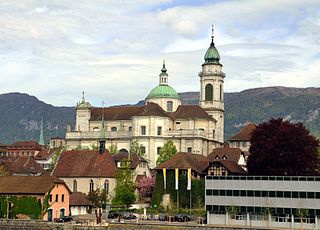
Further Austria, Outer Austria or Anterior Austria was the collective name for the early possessions of the House of Habsburg in the former Swabian stem duchy of south-western Germany, including territories in the Alsace region west of the Rhine and in Vorarlberg.

Hans Erni was a Swiss graphic designer, painter, illustrator, engraver and sculptor. Born in Lucerne, the third of eight siblings, to a cabin cruiser engineer, he studied art at the Académie Julian in Paris and later in Berlin, and admired artists such as Pablo Picasso and Georges Braque. He is known for having illustrated postage stamps, his lithographs for the Swiss Red Cross, his participation on the Olympic Committee as well as his activism. His 1939 works and first major public success was a mural titled Switzerland: "Vacation Land of the People" was commissioned and displayed for the national exhibition in Zürich. The Hans Erni Museum, situated in the grounds of the Swiss Museum of Transport in Lucerne, contains a large collection of artwork, he also designed ceramics and theatre costumes and sets. He did the art for Swiss bank notes, in the 1940s but, after the notes were already printed they were never published, because a member of the State Council of Lucerne criticized that Erni was deemed as a communist. However, Erni was never a member of any political party. In 2004, he was awarded the honorary citizenship of the city of Lucerne. On 10 January 2009 he received the SwissAward for lifetime accomplishment. In his career, he realized about 300 posters and several murals. He illustrated about 200 books and created 90 Postage stamps and 25 medals.

The coat of arms of the Swiss Confederation shows the same white-on-red cross as the flag of Switzerland, but on a heraldic shield instead of the square field.

The Rütlischwur is the legendary oath taken at the foundation of the Old Swiss Confederacy by the representatives of the three founding cantons, Uri, Schwyz and Unterwalden, traditionally dated to 1307. It is named for the site of the oath-taking, the Rütli, a meadow above Lake Uri near Seelisberg. Recorded in Swiss historiography from the 15th century, the oath is notably featured in the play William Tell by Friedrich Schiller (1804).

The Ausbund is the oldest Anabaptist hymnal and one of the oldest Christian song books in continuous use. It is used today by North American Amish congregations.
There was significant emigration of Swiss people to the Russian Empire from the late 17th to the late 19th century. Rauber (1985) estimates that a number of 50,000 to 60,000 Swiss lived in Russia between roughly 1700 and 1917.
The Battle of Sörenberg was fought in 1380, between the Entlebuch and Obwalden. It was the culmination of a conflict over the right to alpine pastures (alps). The immediate cause was a cattle raid at an alp now known as Schlachtalp, at the slope of the Brienzer Rothorn, above the village Sörenberg.

Schenkenberg Castle is a castle ruin above the municipality of Thalheim in the canton of Aargau in Switzerland. It was built in the 13th Century by the Habsburg dynasty, was the administrative seat for 260 years of a bailiwick of the city of Bern and fell into ruin in the 18th century.
Max Wehrli was a Swiss literary scholar and Germanist. Wehrli studied from 1928 till 1935 Germanic and Greek at the Universities of Zurich and Berlin. Among his teachers were Emil Ermatinger, Ernst Howald and Nicolai Hartmann. 1936 he wrote his Ph.D. thesis at the University of Zurich.

Hans-Michael Bock is a German film historian, filmmaker, translator and writer.
Conrad Brunner was a Swiss Benedictine monk. From 1380 until his death, he was abbot of the monastery at Muri in today's Canton of Aargau.

The St. Ursus Cathedral or Solothurn Cathedral is the cathedral of the Roman Catholic Diocese of Basel in the city of Solothurn, Switzerland. It is a Swiss heritage site of national significance.

Nadja Sieger is a Swiss comedian, singer, writer, actress and producer, better known as Nadeschkin of the comedian duo Ursus & Nadeschkin.

The Predigerkloster was a monastery of the Dominican Order, established around 1234 and abolished in 1524, in the imperial city of Zürich, Switzerland. Its church, the Predigerkirche, is one of the four main churches in Zürich, and was first built in 1231 as a Romanesque church of the then Dominican monastery. In the first half of the 14th century it was converted, the choir between 1308 and 1350 rebuilt, and a for that time unusually high bell tower built, regarded as the highest Gothic edifice in Zürich.
Hans Heinrich Schmid was a Swiss Protestant Reformed theologian, University Professor and University Rector.

Ittigen Castle is a historical country house in Ittigen in the Canton of Bern in Switzerland.

Ursela Monn is a Swiss actress and singer.

Jenny Thomann-Koller was a gynecologist, pediatrician, and Head of Internal Medicine at the Schweizerische Pflegerinnenschule mit Spital in Zurich. In her dissertation, Beitrag zur Erblichkeitsstatistik der Geisteskranken im Ct. Zürich. Vergleichung derselben mit der erblichen Belastung gesunder Menschen u. dergl., published in 1895, she introduced a control group which challenged the then-popular theory of degeneration and eugenics.














